Makers Going to Make
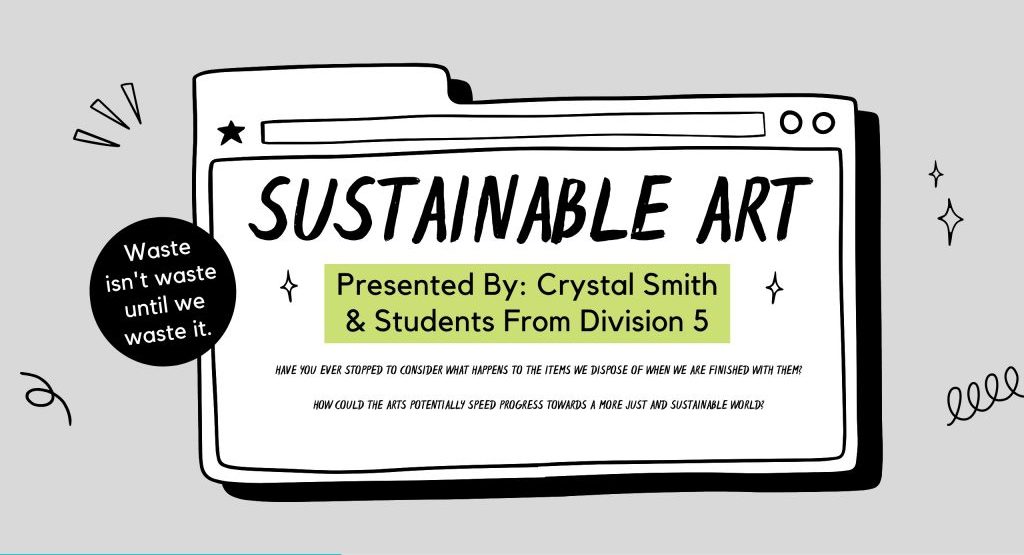
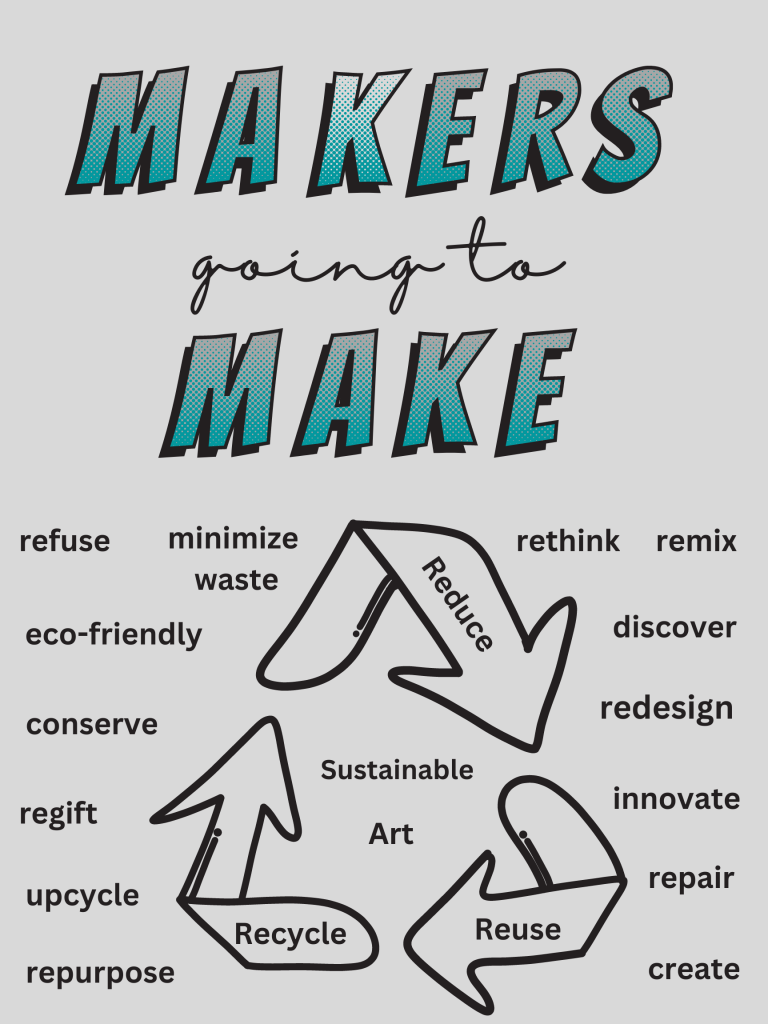
January 31, 2023
Transforming Everyday Objects Into Art
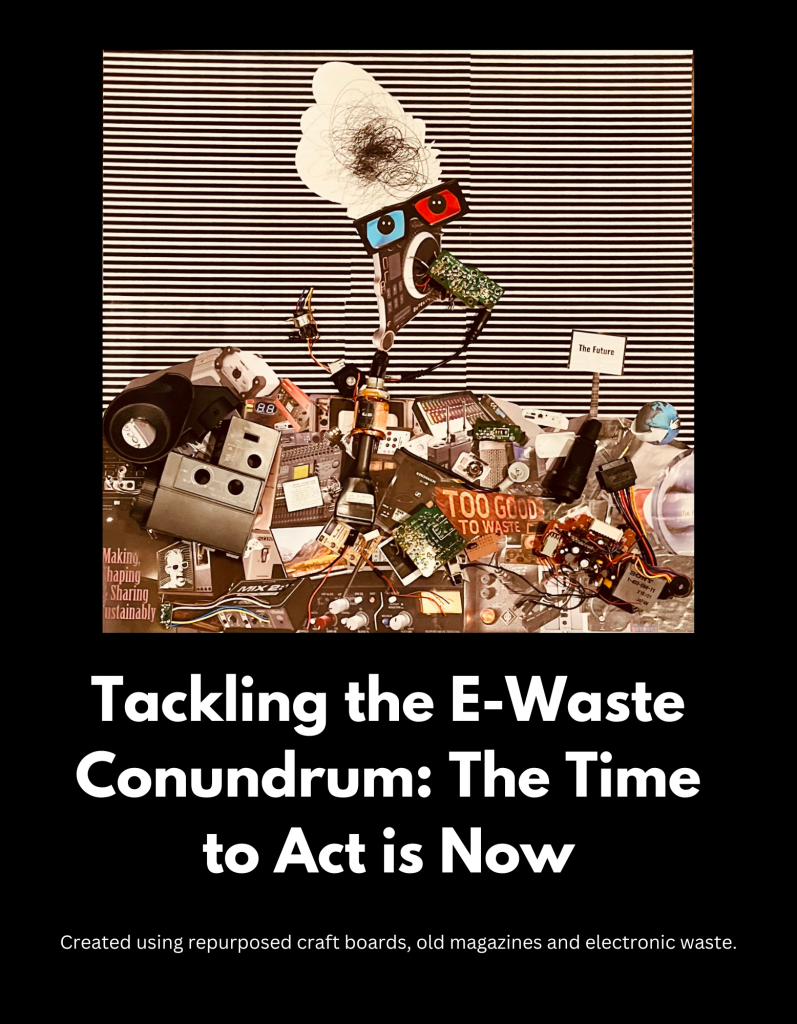
February 4, 2023
Repurposed VHS Planter
Remember when VHS tapes were the gold-standard in movie rentals? Seems like forever ago, doesn’t it? And where are all those VHS tapes now?
VHS tapes have become obsolete so why not repurpose them into planters to prevent them from collecting dust in your home or further yet ending up in a landfill?
Here is my attempt at repurposing an old VHS I will never use again.
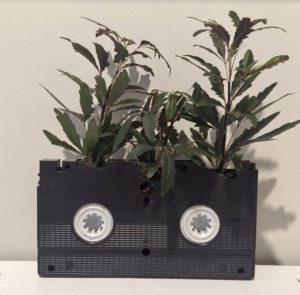
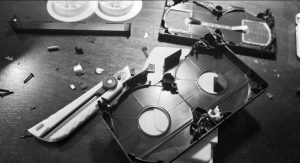
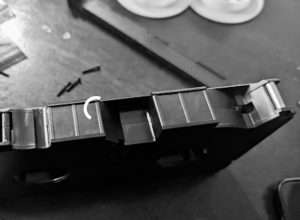
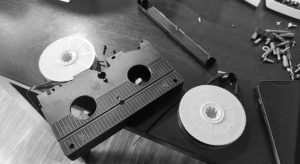
February 5, 2023
Recycled Steel Can, Forks and Spoons Planters
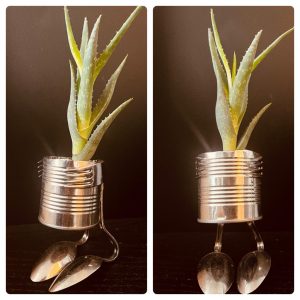
What things can you create from items found in your recycling bin or mix matched items you no longer need or want? How might you repurpose these items to create something new and useful?
February 14, 2023
Random Acts of Art in Nature Inspired by the Work of Andy Goldsworthy
Andy Goldsworthy is an English sculptor, photographer, and environmentalist who produces site specific sculptures and land art situated in natural and urban settings. He views the inevitable death and decay in his work as part of the life cycle taking an environmentalist’s approach to the creation of art. His work respects the natural world and his artistic creations will gradually fade away into the land from which they’ve come with no direct impact on the environment.
Below is a picture of the found art I created for Valentine’s Day inspired by the work of Andy Goldsworthy.
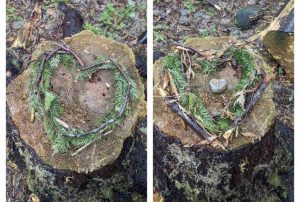
Quotes to Consider:
“If you truly love nature, you will find beauty everywhere.” ~ Laura Ingalls Wilder
“Art takes nature as its model.” ~ Aristotle
“Nature does not create works of art. It is we and the faculty of interpretation peculiar to the human mind, that see art.”~ Man Ray
“Science, like art is not a copy of nature but a re-creation of her.”~ Jacob Bronowski
“I think having land and not ruining it is the most beautiful art that anybody could ever want.”~Andy Warhol
Questions for further thought when you discover found art in nature:
What found art have you discovered in nature?
How did you react to it? How did it make you feel?
What does this type of art make you think of?
How do you think the artist wants you to engage with their artwork?
What challenges do you think the artist would have with creating land art with items found in nature?
What natural elements were used to create the artwork?
What elements or principles are depicted in the art?
Are there any negative and positive spaces depicted in the artwork?
What significance or meaning might the artwork have?
How will the art change as it is exposed to other natural elements and processes? Would this then change how people view and interact with the art?
Assignment:
Task: Create a piece of art using only found items from nature inspired by the work of Andy Goldsworthy.
Think about how to best represent your sculpture in a single image. Once you have captured an image of what you’ve created please share it with the class.
Criteria: Your art must be created from natural items found in nature and the artwork you create must remain in nature. Once you have created your art upload a picture of your artwork in its natural setting to your Spaces account along with your answers to the following questions:
How did you demonstrate the elements and principles of art (balance, contrast, line, shape, pattern, etc) in your artwork?
Does your artwork have radial, symmetrical, and or asymmetrical balance? How do you know?
What did you enjoy about this activity?
What was challenging for you?
What would you like people to see in your artwork?
How do you want people to interact with your artwork?
Student Creations:
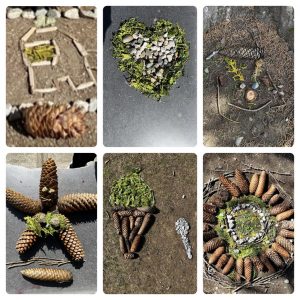
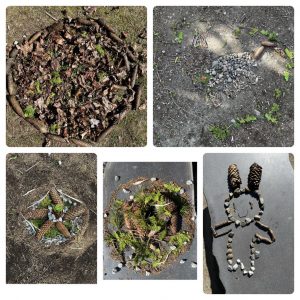
March 3, 2023
Here are some books I’ve been reading that offer tips for making your own paper, paints, jewelry, and crafts from recycled materials and other everyday items that won’t harm the earth. If you are looking for sustainable art ideas, nature, or science based activities to do with your children I recommend taking a look at some of these resources.
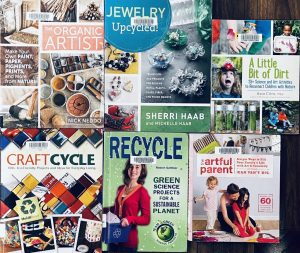
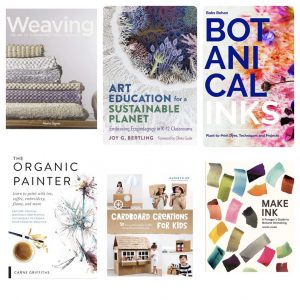
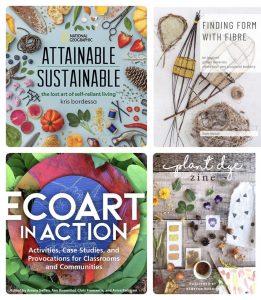
March 4, 2023
Creating Watercolor Paints With Coffee
Today I discovered this video produced by Art Lab with Miss Neff about painting with coffee and thought I’d give it a try. Here is the link to the tutorial for how to create different values, textures, and layers using coffee. I highly recommend watching this video and testing how you can create different values, textures, and layers before creating your own watercolor masterpiece.
Link to Tutorial:
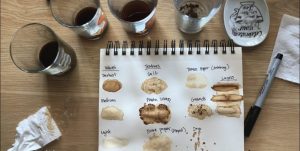
Coffee painting landscape tutorial with ARTBY_AVANII:
Here is my attempt at creating a coffee painted landscape inspired by the work of ARTBY_AVANII.
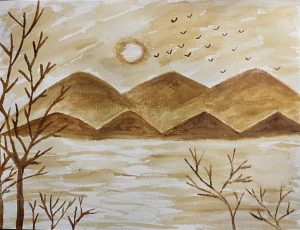
March 5, 2023
What am I currently learning in this making journey?
Some of the things I’m learning on this making journey include:
- how to repurpose recycled materials or trash that would end up in a landfill
- how to create art using found items in nature
- how to create place based art that draws awareness to cultural, political, and social issues.
- how to critically evaluate images and and artifacts of art and visual culture by considering issues of power, persuasion, privilege, and politics to bring about social consciousness, and advocate for change.
Where did I start? Where am I now? Where am I going?
When I began this making journey I didn’t really think twice about buying materials for art lessons and would often just purchase what I need to make my own art or complete art projects with my students. Now before purchasing art supplies I’m considering how I might use natural items or things that are readily available that could be repurposed or reused. This is allowing me to reduce the amount of trash I throw away and think of other creative uses for it. Through this process I’m also learning how to create my own paints using natural pigments, which are more eco-friendly than commercial paints that often contain toxic ingredients. As I continue this making journey I’d like to continue exploring how to make my own paper, pigments, dyes, inks, and paint. I’d also like to continue to expand on the 3 R’s (reduce, reuse, and recycle) and consider how to incorporate 5 additional R’s (rot, refuse, repair, repurpose, and rethink) in the making I do for myself and with my students.
What evidence from my making illustrates my growth?
The making and artwork I’ve done thus far illustrates that I am able to repurpose recycled materials and other trash to create art that is a vehicle for environmental art activism. I have also demonstrated that I can create art using found items in nature and create watercolours from everyday food items (ie. coffee) that are not harmful or toxic to the environment.
What is the connection between me learning this new making and my journey through the GDE (Graduate Diploma of Education) program?
Through this making and the coursework I am doing through SFU I am learning that:
- it is possible to weave the arts and non-art curriculum together
- making art about places can involve students in many layers of thinking and action as place-based ideas converge with critical theory.
- that art can move from being solely about personal expression toward a vision of teaching that engages students in reflective social process within the larger community.
- we are interwoven with our own ecologies and the places we are “indigenous” to and indigenous knowledge offers lessons that can benefit everyone as we search for more satisfying and more sustainable ways to live on this planet.
In our society and within the current climate it is really important that we educate students about the issues facing our planet and help them strengthen their connections to others, their region, and to the land. It is also important for them to develop an appreciation for the natural world and help them become more responsive, socially aware, and reflective citizens who are stewards of the land they reside on. By connecting their learning to real-world experiences and teaching them about the 8 R’s through art and other integrated units of study it is my hope that students will begin to think critically about sustainability and the issues facing our planet. Through these practices I also hope to encourage them to develop their own more sustainable practices in their everyday lives.
March 11, 2023
Key Learning/Takeaways From Don’t Be Trashy By: Tara McKenna
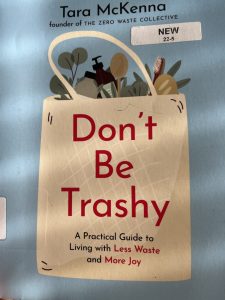
In society we have a waste problem and need to learn to live more sustainably.
The Waste Problem (extract -> produce -> purchase -> toss -> repeat)
Lifestyle, marketing and planned obsolescence have lead us to this problem.
How can we adopt a zero waste or low waste lifestyle?
Conduct a Trash Audit and identify where discarded items end up when they are no longer needed (landfill, recycling, organics, hazardous waste)
Are there any patterns emerging in terms of the types of waste you tend to throw out the most?
Now that you know your recycling system, are there ways you can reduce your landfill waste and recycle better?
What goals do you want to achieve over the next year to create less trash?
Are there ways you can reduce the materials you place in your recycling bin?
Keep the results of your trash audit handy and conduct another trash audit in 3-6 months. Compare it to where you started. What went well? Where can you still improve? Then set a new goal for yourself to reduce your trash even more.
Relearn the 3 R’s (reduce, reuse, recycle) and add these 5 R’s (rot, refuse, repair, repurpose, and rethink).
Find your “why?”
Questions to consider when purchasing or disposing of items:
Where was this made? Is this product local or imported?
Was this made ethically or sustainably?
What materials were necessary to make this?
Could this have toxic chemicals in it?
Watch the documentary Stink about common household products loaded with harsh chemicals.
Can I repair this or have it repaired by someone else?
Could this easily be recycled?
Connection between minimalism and waste: each time we shop we are supporting the system and more resources need to be extracted, refined, and transported so that new products can be manufactured, packaged, and shipped, which can lead to habitat loss, pollution, and waste.
Take gently used items to the thrift store, sell, or donate the items-one persons trash is another persons treasure.
Develop tactics to avoid recluttering and save money while reducing your waste at the same time.
Curb impulse shopping-keep a wish list, avoid your known triggers, reduce exposure to ads, buy for your real life, pursue hobbies you enjoy, develop your sense of style, and set up rules for yourself.
Ask yourself do I really need this?
Do I have something at home already that serves the same purpose?
Will I want to maintain and repair this?
Could I borrow or rent this instead of buying it?
What else could I use this money for?
Do I have the money to spend on this right now?
“Everything is 100% off if you don’t buy it.”
Use what you have, borrow it, rent it, swap it, find it for free, make it yourself, thrift it, buy it better.
Conduct a pantry audit, find low waste grocery and kitchen options, shop with reusable bags and containers, reduce food waste, start composting, and consider what you eat.
Use containers/jars to store bulk items, reduce buying things that contain soft plastics, and make things from scratch yourself.
Recommended Documentaries-A Plastic Ocean Book-A Life on Our Planet.
Break up with fast fashion, know your lifestyle, dress for the weather, choose a color palette, create a vision board, copy outfit ideas, try things on, create a uniform, make lists, create a title and mission statement for your style, fill your closet sustainably, choose quality clothes, buy less but better, become an outfit repeater, mix and match, add accessories, and swap with friends.
Master the subtle art of refusal. Refuse junk mail, move bills and paperwork online, refuse freebies, and cancel physical subscriptions.
Gifts-return it, regift it, sell it, give it away.
Holidays-reusable bags, newspaper, save and reuse bows and ribbons.
Gift experiences rather than physical gifts (digital subscriptions, gym membership, lessons, spa services, vacation/holiday, gift consumables, donations).
Have a “no buy” month.
Shop local, create a green team at work or school, and get critically engaged.
Beneficial side effects: less stress, a healthier lifestyle, more financial savings, new skills, broader knowledge that enables you to teach others along the way, and positive feelings of contribution.
March 31, 2023
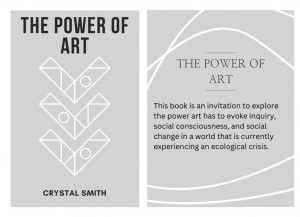
https://www.mixbook.com/photo-books/interests/blank-canvas-30662042?vk=5QiecHQVf9qeobFw1kwr
April 7, 2023
Eco-Dye Your Own Easter Eggs
Step 1: boil one dozen eggs and rinse in cold water. Then soak your hard boiled eggs in vinegar for 5-10 minutes. The vinegar is essential in helping the colours adhere to the shell. You can skip this step but your colours will be more muted
Step 2: boil food items, prepare tea/coffee, and dilute spices with hot water to prepare natural dyes.
Step 4: when you are satisfied with the colour remove the eggs from the dye and enjoy.
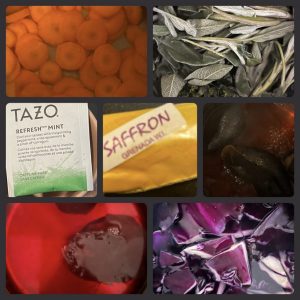
Image 1: preparing the dyes
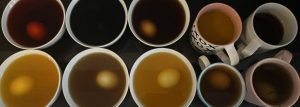
Image 2: the dyeing process
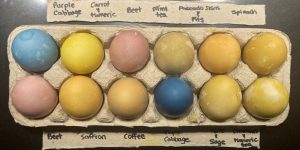
Image 3: dyed Easter Eggs
April 7, 2023
Found Vegetable Art
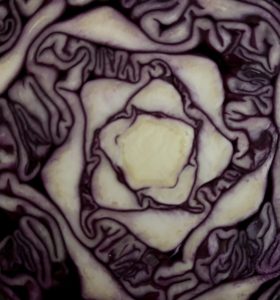
What elements or principles of art do you see in this purple cabbage?
April 7, 2023
Saffron and Coffee Watercolour Easter Card
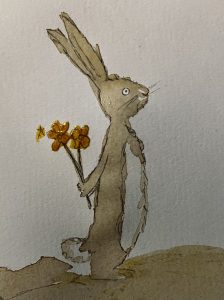
April 8, 2023
Hapazome’ Eco-Printing for the Impatient Eco-Artist
Hapazome’ is a term coined by textile artist India Flint, who creates ‘leaf dye’ by pounding or hammering leaves and flowers. The dye then transfers to the paper or cloth leaving beautiful eco-prints. Today I thought I’d give it a try with my daughter and I must say the hammering made it really fun. Here are the cards and bookmarks we made on watercolour paper:
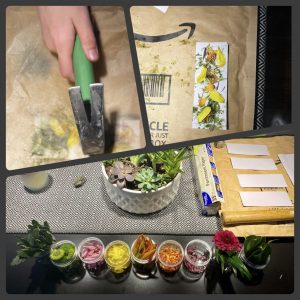
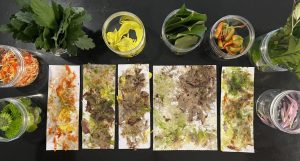
Once they finish drying we will likely add some tassels with odds and ends of string or yarn we have laying around the house. This was a really fun activity and I love the beautiful non-toxic nature prints that remained from our Hapazome’ Eco-printing art session.
April 14, 2023
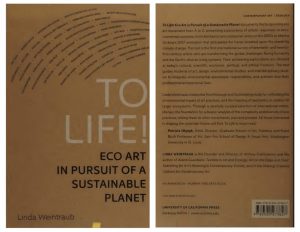
April 18, 2023
Pollinating Wildflower Seed Papers for Earth Day.
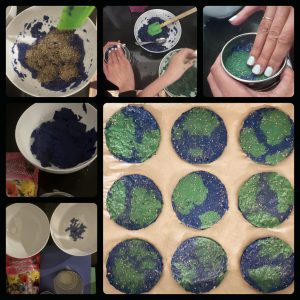
Here is the step by step instructions for making the seed paper which I obtained from Views From a Step Stool.
It’s very easy to make and a great way to spread nature and enjoy the outdoors. As pollinator plants, wildflowers help to support declining bee populations and they create a habitat for birds, butterflies and other insects. Some wildflower species and insects have become extinct due to increased agriculture and by planting wildflowers we can help keep these species alive and maintain a healthy eco-system.
Wildflowers are low maintenance and easy to grow. They can be used in parts of the garden which are difficult to cultivate conventionally because they have naturally adapted themselves to suit difficult situations in order to survive. Also, like all plants, wildflowers will help improve the air quality of our planet
Whether you are planting the seed paper indoors or out, it should be placed under a thin layer of soil. 1/8″ – 1/4″ is ideal. Definitely no deeper than 1/4″. Wildflowers LOVE the sun so pick a location that has plenty of sunshine throughout the day. Soak the soil & seeds right after planting, although avoid having the water pool on top, and then water as needed, usually every 2-4 days depending on how hot and dry the location is. You should start to see sprouts in around 5 days!
April 22, 2023
What am I continuing to learn in this making journey?
Some of the things I’m still learning about on this making journey include:
- how to repurpose recycled materials or trash that would end up in a landfill
- how to create art using found items in nature
- how to create place based art that draws awareness to cultural, political, and social issues.
- how to critically evaluate images and and artifacts of art and visual culture by considering issues of power, persuasion, privilege, and politics to bring about social consciousness, and advocate for change.
- how to be a sustainable and eco-friendly artist by choosing the right surface, printing options, and inks/paints/dyes, while also limiting my waste and disposing of things in a way that is not harmful to the environment.
I’m also learning how to make:
- natural dyes and eco-friendly paint.
- recycled paper
- wildflower seed paper
- recycled planters
- found art
- recycled art
- eco-prints and eco-dyed fabrics
- digital art
- a digital picture book
- changes to my own consumption and waste and learning to adopt a low waste lifestyle
Where did I start? Where am I now? Where am I going?
When I began this making journey I didn’t really know a lot about sustainable or eco-friendly art practices or materials. As I continue to research and test out new ideas, I continue to look for new and creative ways to make my own environmentally friendly art supplies rather than buy materials that contain chemicals that are harmful to the environment. I’m also continuing to explore ways to reduce my consumption and waste, while also learning ways to repurpose trash and recycled materials to keep it from ending up in a landfill.
As I continue this making journey I plan to continue learning more about how to make my own paper, pigments, dyes, inks, and paints that are environmentally friendly. I’d also like to learn more about eco-conscious art practices and learn how to create art from plastic waste while also raising awareness about single use plastic pollution.
What evidence from my making illustrates my growth?
The making and artwork I’ve done thus far illustrates that I am continuing to explore and learn about a variety of eco-art, eco-conscious, and environmentally friendly art practices. I’ve also been able to take what I’ve been learning and teach it to my students.
Sustainable Art Inquiry Projects & Making in the Classroom
My students and I are currently working on creating our own sustainable art pieces for a school art exhibit. To introduce this project I showed the students the book I created called “The Power of Art” and some of the art I’ve created this year to inspire them. I then assigned them an inquiry project where they had to learn about various artists from around the world who create environmental and sustainable art. They engaged in research to learn more about these artist’s sustainable art practices and presented their finding to the class.
Here is a link to the student’s artist presentations:
http://sd41blogs.ca/smithc/artist-research/
Also here my integrated lesson on art and sustainability:
Gallery of Teacher and Student Work
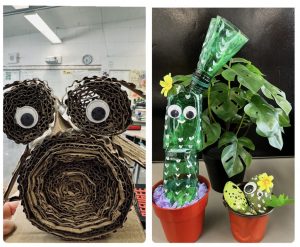
What is the connection between me learning this new making and my journey through the GDE (Graduate Diploma of Education) program?
Through this making and the coursework I am doing through SFU I am still learning that:
- it is possible to weave the arts and non-art curriculum together.
- making art about places can involve students in many layers of thinking and action as place-based ideas converge with critical theory.
- that art can move from being solely about personal expression toward a vision of teaching that engages students in reflective social process within the larger community.
- we are interwoven with our own ecologies and the places we are “indigenous” to and indigenous knowledge offers lessons that can benefit everyone as we search for more satisfying and more sustainable ways to live on this planet.
I’m also discovering ways to incorporate what I am learning within my own teaching practice. This is helping the student and I strengthen our connections to others, the region, and to the land as we learn more about sustainability and the issues facing our planet. Through this work we are all developing an appreciation for the natural world and learning to become responsive, socially aware, and reflective citizens who are stewards of the land we reside on.